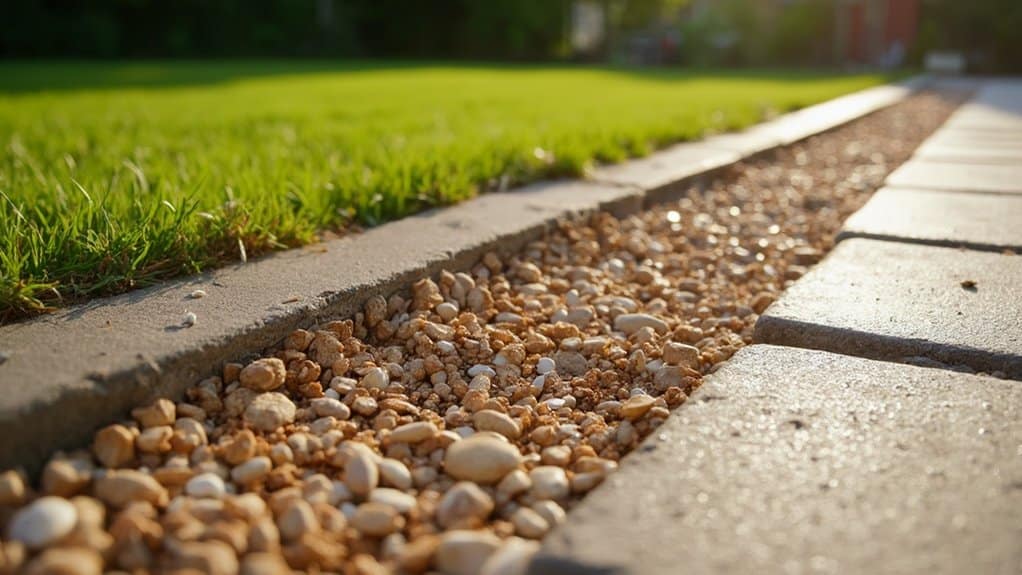A solid concrete or tarmac sub-base forms the essential foundation for resin-bound gravel. For proper installation, lay at least 100mm of compacted MOT Type 3 aggregate. This prevents common issues like sagging and cracking whilst ensuring proper water drainage. Strong edge restraints, such as block paving or metal strips, are crucial to maintain the surface's integrity. Think of it like building a house – without proper foundations, the structure won't last.
Key Takeaways
The ideal bases for resin-bound gravel:
Concrete serves as the strongest foundation, perfect for driveways where cars regularly park and busy garden paths.
Tarmac offers a budget-friendly choice but must be properly set and laid at 100mm deep to last.
Grid systems bring flexibility and excellent drainage, ticking the box for SuDS regulations whilst allowing immediate use after installation.
A proper foundation is vital – use MOT Type 3 sub-base at 100mm depth, well-compacted to stop water collecting and weakening the surface.
Sturdy edging is a must-have, keeping the whole surface stable and preventing the gravel from shifting about.
Understanding Resin-Bound Gravel and Its Applications
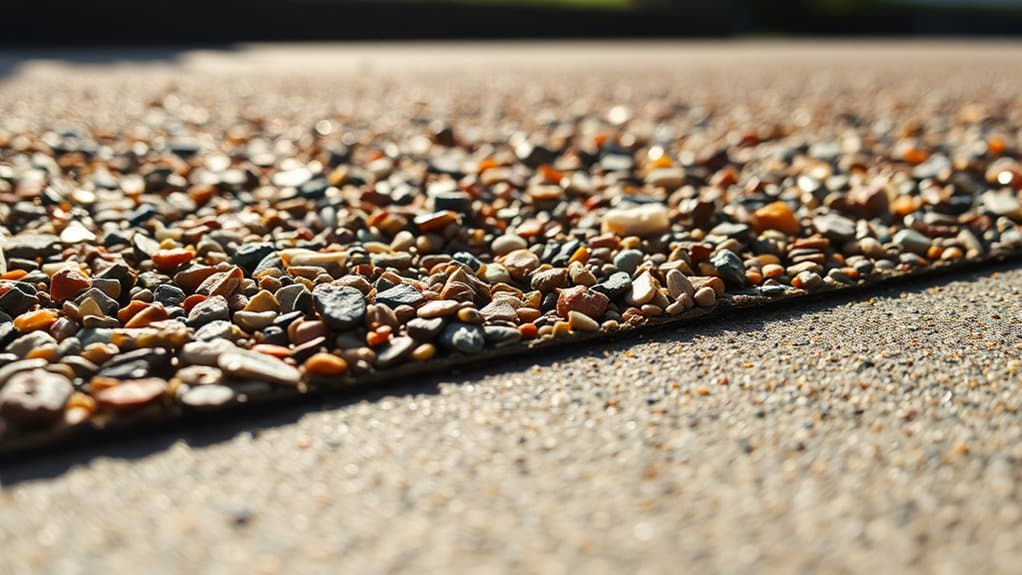
Resin-bound gravel offers a perfect mix of practicality and style for modern surfacing needs. Its key advantages include outstanding durability and minimal upkeep, suiting everything from home driveways to shopping centres. The surface works brilliantly for paths, patios and public areas, whilst its permeable nature helps prevent flooding – a particularly useful feature given Britain's wet weather. Installation involves blending stone aggregates with resin to create a smooth, safe surface. Think of it as mixing concrete, but with a far more attractive finish. Available in countless colours and designs, from subtle greys to warm browns, it's easy to match any property style. This sustainable option ticks all the boxes for SUDS requirements (essential for new builds), handles constant foot traffic and vehicle use, and looks smart for years. Additionally, resin-bound gravel is a SUDS compliant solution that reduces the impact of surface water from urban developments. The permeable surface also aids in effective water management and reduces pressure on local drainage systems during heavy rain. For anyone seeking a low-maintenance, long-lasting surface that looks proper, resin-bound gravel is a solid choice.
Importance of a Stable Sub-Base
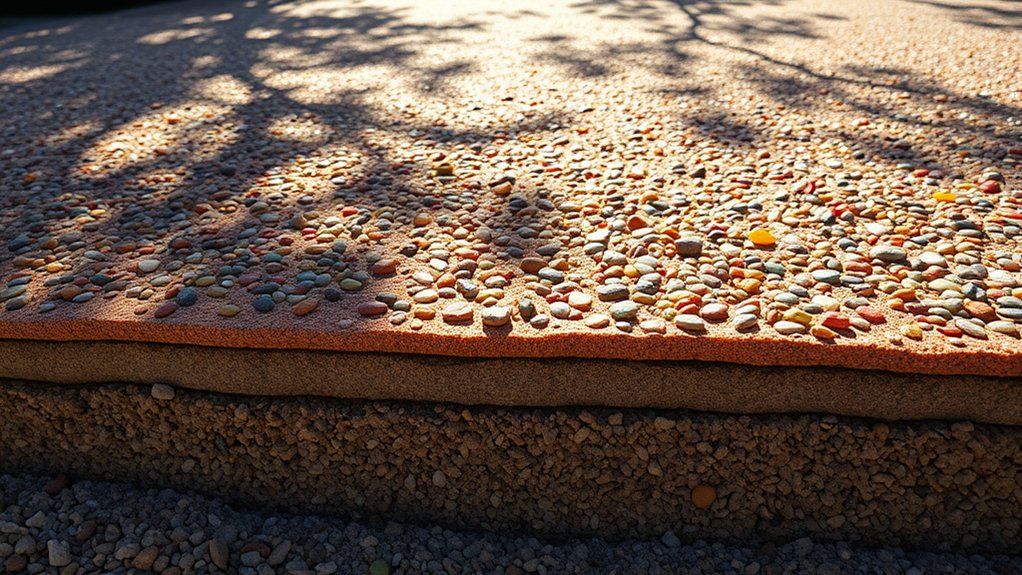
A proper sub-base is crucial for lasting resin-bound gravel surfaces. The standard depth should be at least 100mm using MOT Type 3 aggregate, thoroughly compacted to ensure stability. Think of it as building a house – without solid foundations, the structure won't last.
The sub-base does two key jobs: it supports the resin surface above and spreads weight evenly across the whole area. Skimping on depth or poor compaction often leads to dips and cracks, particularly in areas with heavy foot traffic or where cars park. Proper drainage is equally important. A well-built sub-base allows water to flow through rather than pool underneath, which would otherwise weaken the surface during freeze-thaw cycles common in British weather. Additionally, using Type 1 MOT stone in layers can enhance the durability of the base.
These basics might seem obvious, but they're often overlooked. Getting the sub-base right at the start means avoiding costly repairs later. Additionally, selecting the appropriate sub-base type ensures effective drainage and prevents damage to the resin-bound surface.
Types of Suitable Bases for Resin-Bound Gravel
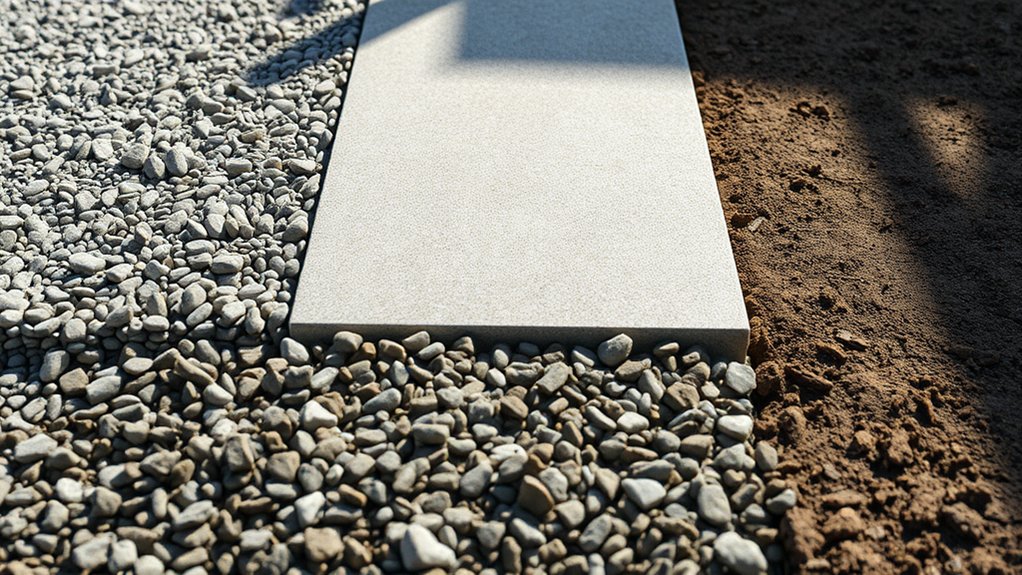
The right base for resin-bound gravel makes all the difference to your installation's durability and finish.
| Base Type | Key Features |
|---|---|
| Concrete | Strong, ideal for high-traffic areas. |
| Tarmac | Cost-effective, low maintenance. |
| Grid Systems | Flexible, permeable, instant use. |
| Permeable Bases | SuDS compliant, good drainage. |
Concrete offers excellent strength – perfect for driveways and busy pathways. Tarmac provides a cost-effective option but needs proper thickness and time to cure. Modern grid systems like EcoGrid are brilliant for quick installations, supporting heavy loads straight away. Permeable bases work well in areas prone to flooding or where drainage is crucial, such as garden paths. Ensuring your base is made of MOT type 3 sub-base is essential for optimal installation and long-lasting performance. Additionally, proper surface preparation before laying the resin-bound gravel will enhance overall durability.
Selecting the right foundation ensures your resin-bound surface stays looking smart and performs well for years to come.
Recommended Sub-Base Materials and Depths
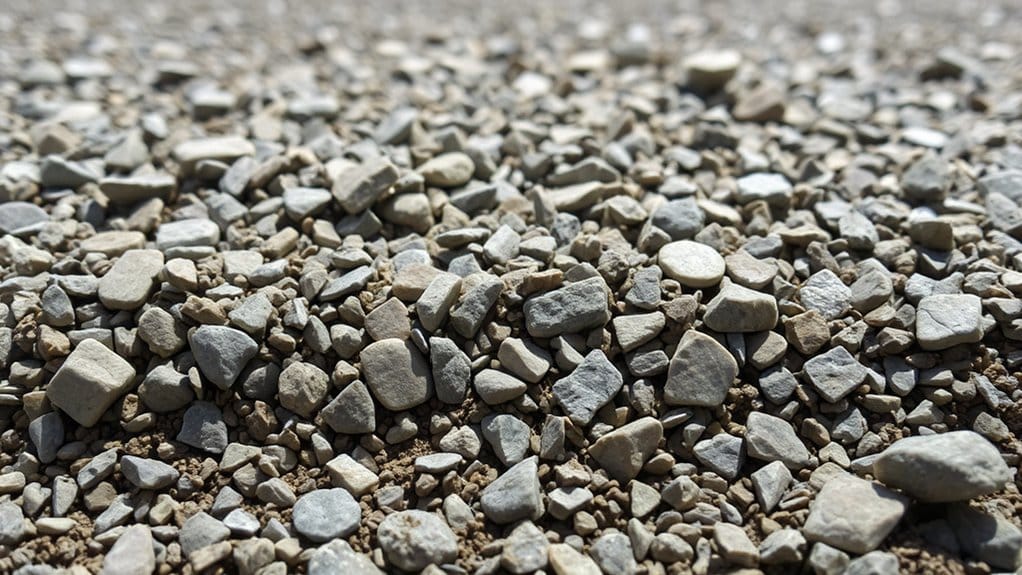
The right sub-base materials and depths are crucial for a stable resin-bound gravel surface.
Tarmac or MOT Type 3 (thoroughly compacted) work best as sub-base materials, and both must be frost-resistant. Install at a minimum depth of 100mm, ensuring proper compaction for durability.
For concrete bases, use C35 grade with steel mesh reinforcement at joints. Strong edge restraints are essential to stop surface movement.
Both tarmac and concrete need proper curing time – typically up to two weeks.
Where traditional bases aren't suitable, modern alternatives like EcoGrid or mesh systems provide good options.
These still meet SuDS requirements for proper drainage whilst offering more flexibility.
Factors to Consider When Choosing a Base

Choosing the right base for resin-bound gravel isn't complicated when you know what to look for. Your base needs to handle regular foot and vehicle traffic without giving way – think of it like building a house's foundations.
Concrete or tarmac are solid choices for most UK projects, especially given our wet weather.
The British climate means you'll want a base that copes well with rain, frost and seasonal changes. Permeable bases, including eco-grids, work brilliantly for meeting local planning rules about surface water drainage. They're particularly useful in areas prone to flooding or where councils have strict drainage requirements.
For most domestic driveways and paths, a properly compacted MOT Type 1 sub-base topped with either concrete or tarmac does the job nicely. The key is matching your base to your site's conditions – a sloping garden in Yorkshire needs different drainage consideration than a flat plot in Essex.
Remember to check local building regulations, as requirements can vary between councils. A well-chosen base will keep your resin-bound surface looking smart and performing properly for years to come.
Preparing the Base for Installation
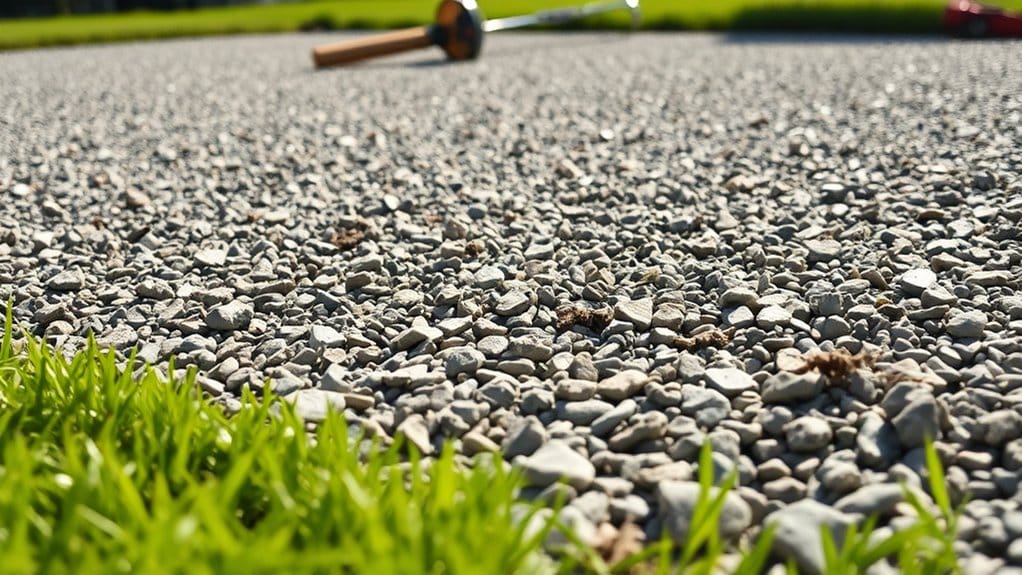
Check your existing surface thoroughly for cracks, dips or damage before laying resin-bound gravel.
The base must be completely dry and properly cured – any trapped moisture will affect how well the resin bonds.
Getting these basics right ensures your new surface will last longer and perform better.
Inspect Existing Surface
Before installing resin-bound gravel, a proper surface inspection is crucial. Start by looking for cracks and damage across the area. Check for uneven spots and signs of wear that could affect your new surface. Large cracks or unstable areas might require complete removal, and you can save old materials for edging.
Test the base for dampness, as excess moisture will stop the resin from bonding properly.
You'll also need to check the ground stability to work out the right digging depth – think about what the surface will be used for, such as cars or just foot traffic.
A careful inspection now prevents headaches later and ensures your resin-bound surface lasts longer.
Ensure Proper Curing
Proper Curing for Your Surface
Once you've checked and fixed any surface issues, focus on getting the curing right for your resin-bound gravel. Poor curing can lead to cracks and warping, so it's vital to get it spot-on.
Key points for proper curing:
- Leave the surface untouched for 24 hours minimum
- Watch the weather – temperature and moisture levels matter
- Use covers if rain is forecast
- Check the base remains dry throughout
These straightforward steps will ensure your resin-bound surface sets properly and lasts for years.
Think of curing like setting a cake – rush it or expose it to the wrong conditions, and you'll end up with poor results.
Take your time, follow these basics, and you'll get a solid, durable finish.
Maintenance Tips for Resin-Bound Gravel Surfaces
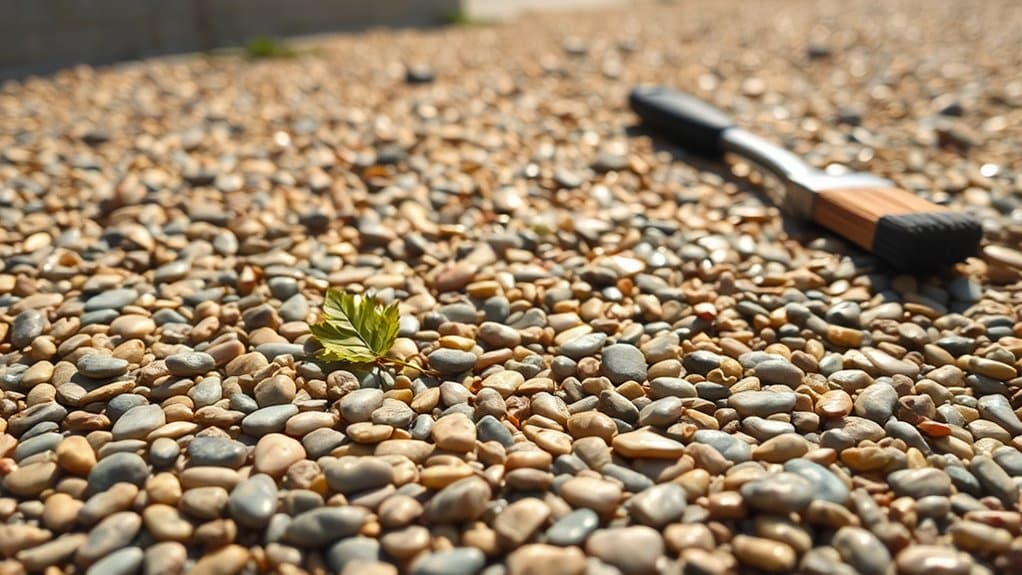
Regular care keeps resin-bound gravel surfaces looking smart whilst maintaining their practicality.
Sweep regularly to shift everyday dirt and give the surface a quick hosing down to clear loose bits. For a proper clean, use warm water with mild washing-up liquid, give it a gentle scrub and rinse well.
Don't let oil spots or bird mess linger – tackle them straight away to avoid permanent marks.
Keep an eye on shady spots where moss and algae tend to grow, particularly common in British gardens, and use suitable treatments to sort them out.
If you're pressure washing, stick to a wide spray setting on medium power to prevent damage. Always test a small patch first.
Avoid dropping heavy tools or garden furniture on the surface, and steer clear of harsh cleaning products – they'll do more harm than good.
Frequently Asked Questions
How Long Does Resin-Bound Gravel Last?
Resin-bound gravel surfaces last around 20-30 years with proper care. Much like a well-maintained garden path, these surfaces need regular sweeping and occasional pressure washing to stay in top form. Whilst hardy against British weather, fixing small cracks or damage quickly helps prevent larger issues and extends the surface's lifespan. Think of it as similar to looking after your driveway – a bit of upkeep goes a long way.
Can I Install Resin-Bound Gravel Myself?
Installing resin-bound gravel as a DIY project is possible, though it requires careful attention to detail. Whilst professionals typically handle these installations, a competent DIYer can manage it with proper planning. The key is getting the basics right: proper base preparation, accurate resin-to-aggregate mixing ratios and swift application before the resin sets. Think of it like laying concrete – timing and technique are crucial for a proper finish.
[Should you need specific tips, many DIY shops across the UK offer detailed guides and materials lists for this type of project.]
What Colors Are Available for Resin-Bound Gravel?
Resin-bound gravel comes in more than 40 colours, ranging from earthy browns and greys to bold reds and golds. Popular choices include natural stone shades that blend well with British gardens and driveways, whilst contemporary options like slate grey and warm terracotta suit modern properties. Each colour can dramatically change the look of your outdoor space, so it's worth considering how your choice will match existing brickwork or garden features.
Is Resin-Bound Gravel Eco-Friendly?
Resin-bound gravel offers strong eco-friendly credentials. The system uses sustainable materials whilst allowing rainwater to drain naturally into the ground, much like a traditional garden. This natural drainage helps prevent flooding and keeps water tables topped up – particularly vital in UK areas prone to water shortages. Unlike concrete or tarmac, which create water run-off problems, resin-bound surfaces work with nature rather than against it. It's a sensible choice for British homeowners looking to create environmentally responsible driveways and paths.
How Does Temperature Affect Resin-Bound Gravel Installation?
Higher temperatures over 30°C significantly accelerate resin curing times – a critical factor when laying resin-bound gravel in the UK. Much like how a hot summer's day affects setting concrete, temperature plays a vital role in achieving proper installation and long-lasting results.
Conclusion
A proper base makes all the difference for resin-bound gravel surfaces. A well-compacted crushed stone sub-base remains the most reliable option for UK properties, offering excellent stability through our varied weather conditions. A recent example from Surrey shows how a correctly installed crushed stone foundation helped a driveway maintain its integrity through several winters. Get the base right, and your resin-bound surface will serve you well for years whilst adding value to your property.
